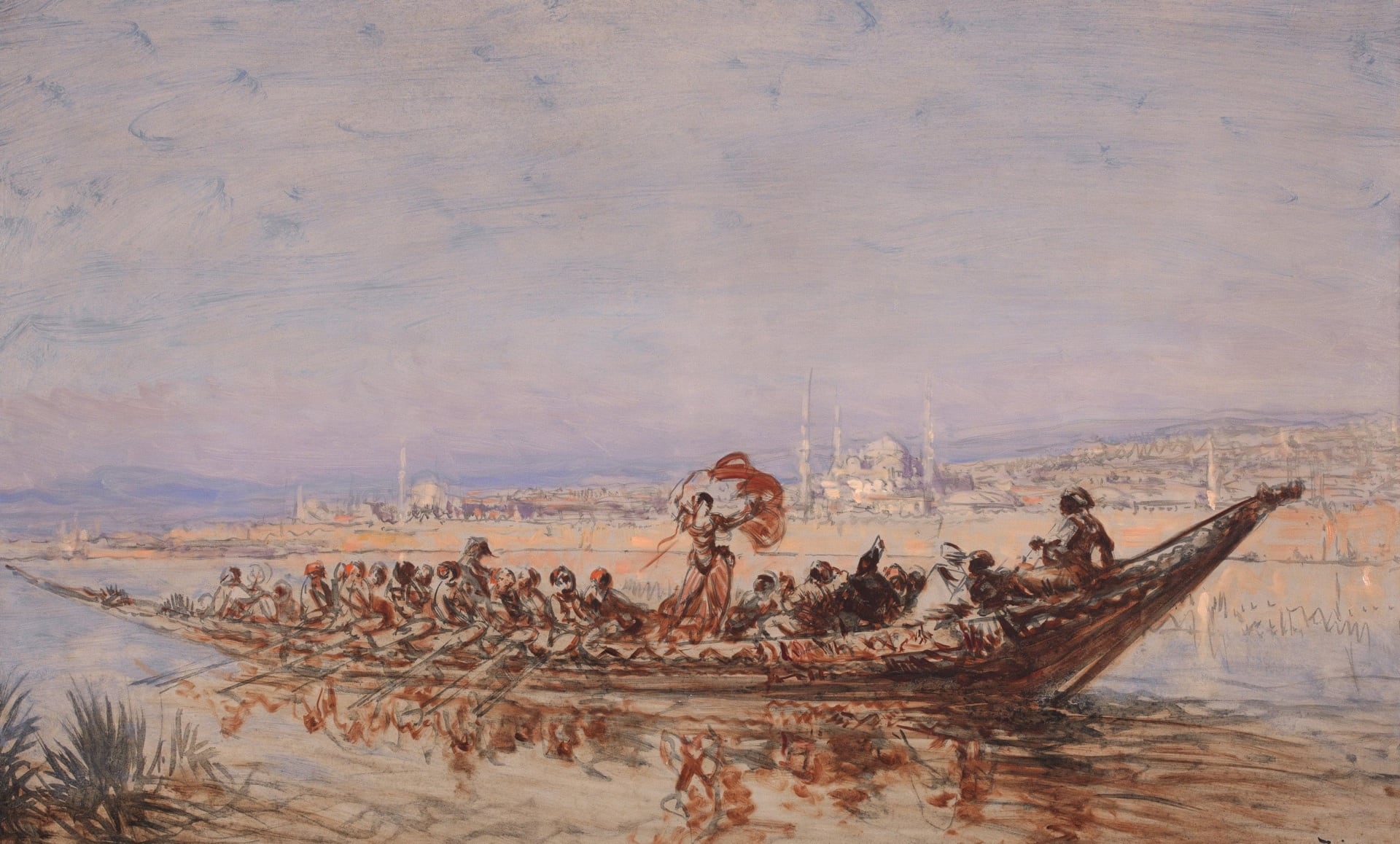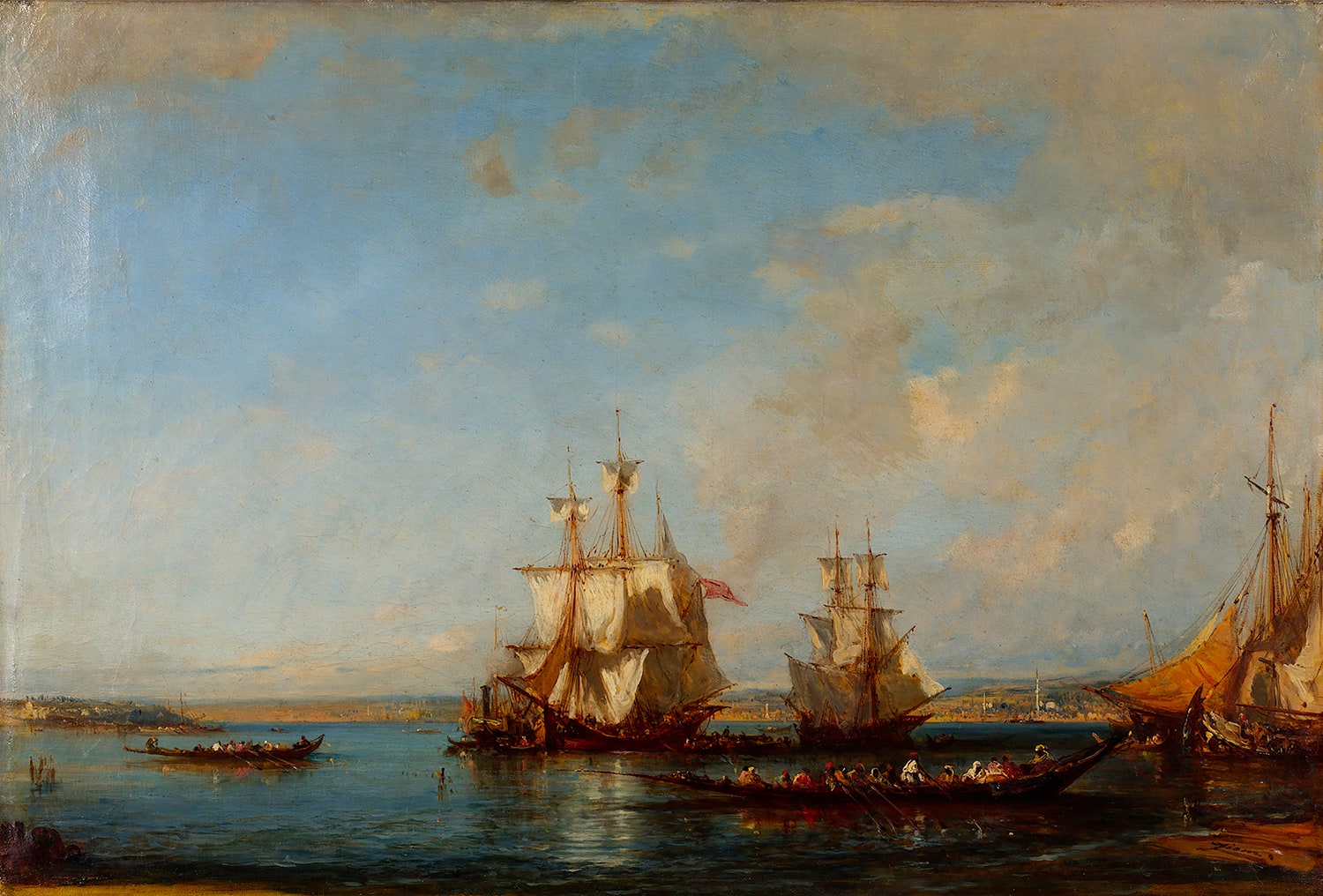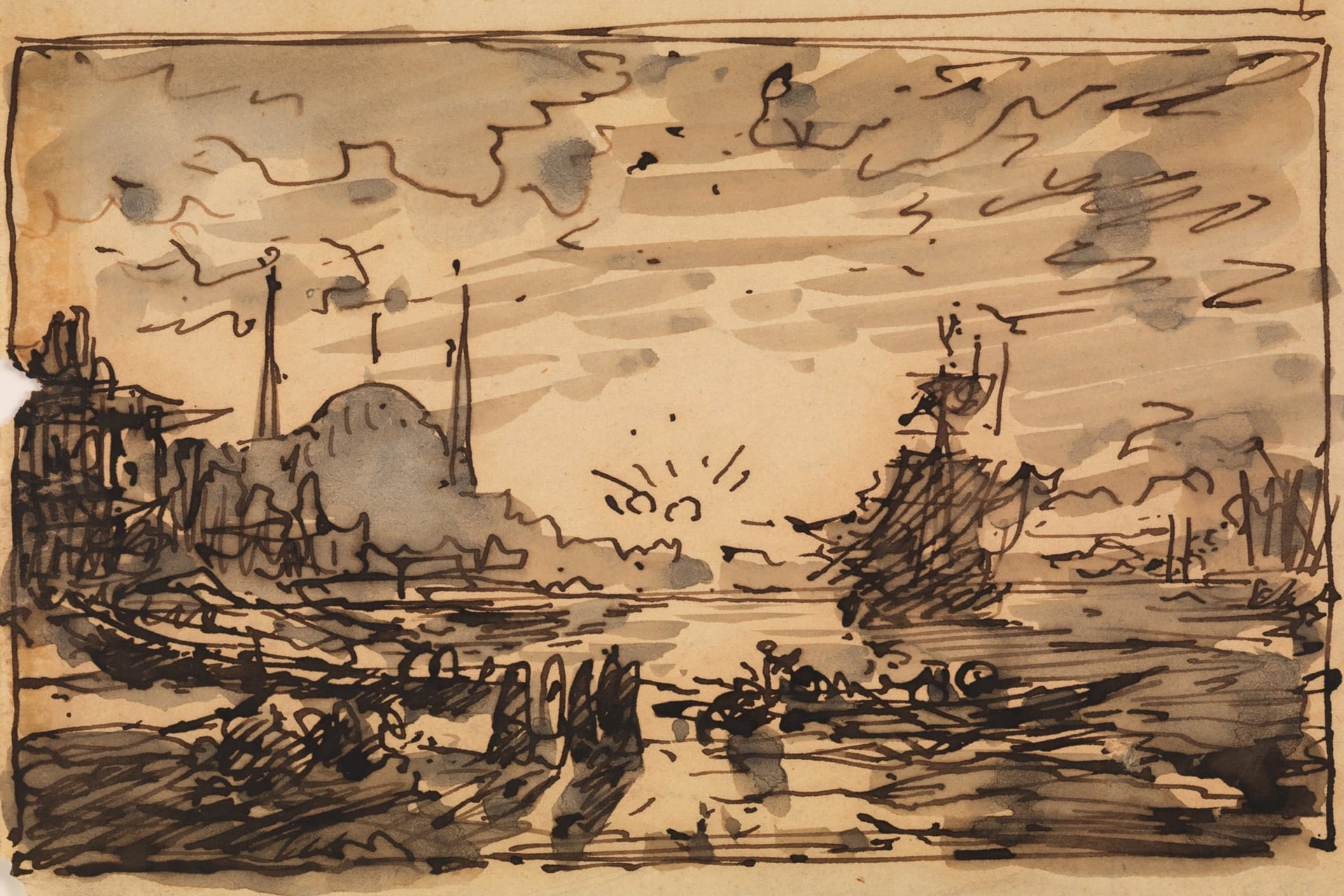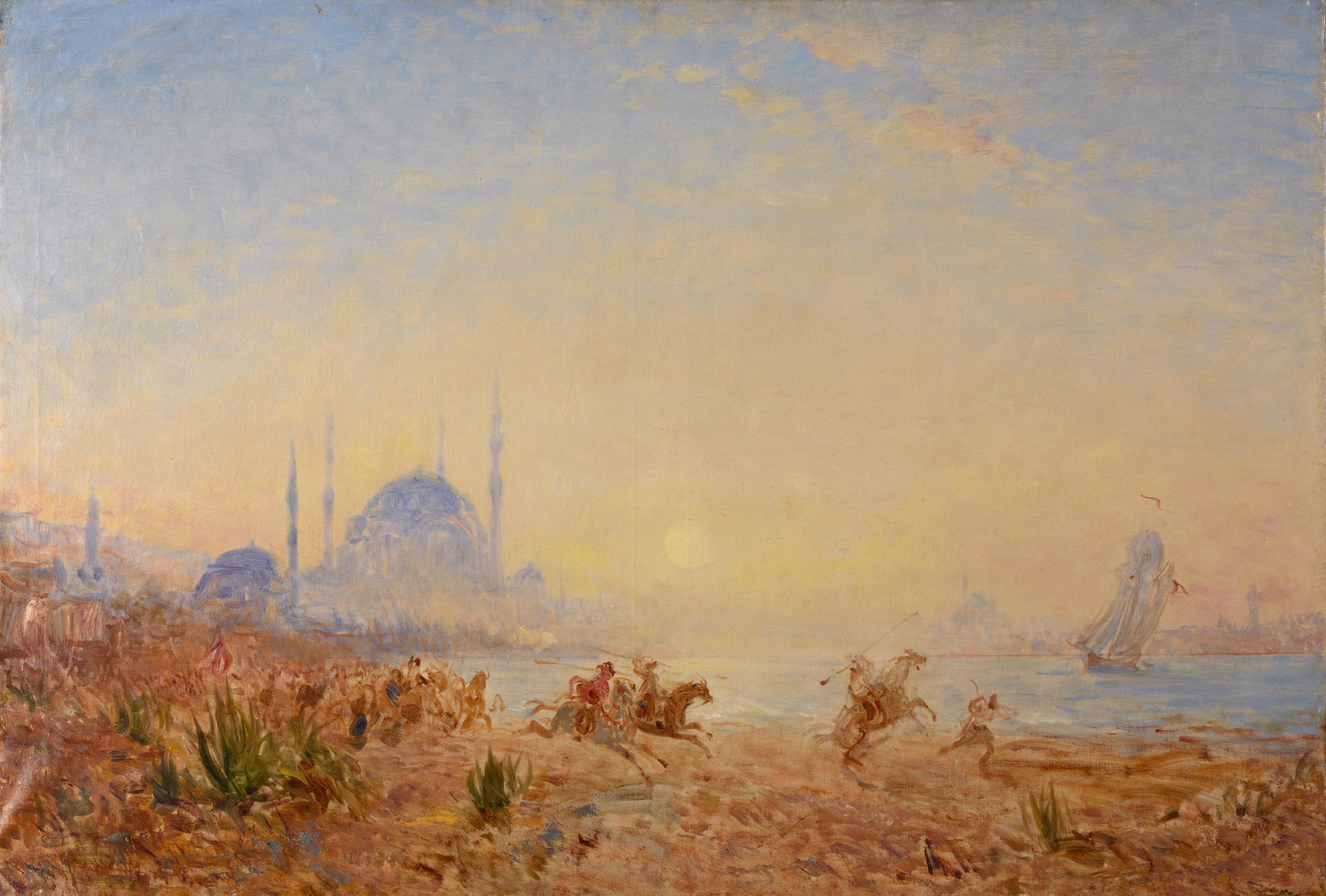15 December 2016
Félix Ziem is accepted as one of the well-known artists of the romantic landscape painting, and has been followed closely by art lovers and collectors of all periods since. He had a profound influence on generations of artists after him, and was the first artist whose works were acquired by the Louvre while he was still alive.
Take a look at this 5 unmissable Istanbul paintings from the exhibition!
1- View of Istanbul

View of İstanbul, Second half of the 19th century, Oil on canvas, 69 x 113 cm., Suna and İnan Kıraç Foundation Orientalist Paintings Collection
Rather than presenting a realistic depiction of the city, this particular İstanbul painting of Ziem also reveals the picturesque aspect of life at sea against the backdrop of the city’s silhouette. The composition of the sailboats and marines in the foreground is balanced by the cityscape with a monumental mosque structure in the background. The artist’s use vibrant colors and his efforts to capture the shimmering effects of the constant change of light with a fast, dynamic brushstroke technique dominate the painting. This style has led Ziem to be compared with Impressionist painters, even to be regarded as an artist who foreshadowed the emergence of Impressionism with his work. The use of brilliant sunlight, which is considered as the major contribution of Orientalist painting to European art, is evident in the cityscape in the background. Figures painted with a few brushstrokes appear in the piyade (light rowboat) in the foreground.
2- Dancer in Caique

Dancer in a Caique, 1870 - 1880, Oil on wood, 69 x 113 cm., Musée Ziem Collection
In this somewhat Orientalist sketch that stands somewhere between a drawing and an oil painting, the artist combines two of his favorite topics – the dancer and the “piyade”-type caique, with the Bosphorus in the background. In Ziem’s paintings, human figures are usually distant and vague, handled with a few touches of color as in the Venetian paintings of artists like Guardi. On the other hand, some of Ziem’s sketches of Istanbul contain a sizeable number of elaborate figures. The attempt to bring together these two different approaches is emphasized with the pochade on this subject that is part of the exhibition
3- Caiques and Sailboats at the Bosphorus

Caiques and Sailboats at the Bosphorus, Second half of the 19th century, Oil on canvas, 55 x 81 cm., Suna and İnan Kıraç Foundation Orientalist Paintings Collection
Felix Ziem must have completed this painting, in which he depicts the animated life of the Bosphorus, after having returned to his country, using the sketches he made in İstanbul. While Zeim was an artist who was able to produce works of various styles such as portraits, still life, genre scenes, and historical depictions, he is primarily renowned as a landscape artist; he was an active member of the Barbizon school, which primarily focused on the depiction of nature. In this painting, İstanbul is represented through a few mosque silhouettes in the background. Nonetheless, as in his Venetian scenes, the painting emphasizes the picturesque union of the city, the sea and human figures, which have been reduced to mere color stains. Ziem, who produced his own paints from natural pigments, influenced other artists with the use of color in his paintings. Van Gogh, for instance, once noted that he would like to “make blues like Ziem does”. The artist is known to have used “lapis lazuli” for the dominant blue color in this painting.
4- Sunset over the Bosphorus

Constantinople, Sunset over the Bosphorus, 1880 - 1890, Pen and brown ink on paper, 10 x 13 cm., Musée Ziem Collection
This drawing depicts the outlines of a romantic and imaginary Istanbul, providing insight into the methods of the artist. It is interesting that even such a small drawing can display the various pronounced aspects of Ziem’s paintings. Light is the major point here and the sun is placed between an exaggerated mosque silhouette and a sailboat. The line of horizon was kept low to give greater space to the sky. Despite the ambiguous outlines of forms, the artist always uses perspective correctly, having been trained as an architect, and here he uses shadows to emphasize perspective. The caique and the pier in the foreground have been used to capture this deep movement towards the sun at the center.
5- Dreamy Istanbul

Constantinople, Fantasia, 1880 -1890, Oil on canvas, 83 x 120 cm., Musée Ziem Collection
Ziem came to Istanbul right after the Crimean War in 1856 for two months, wandering around in the city and making numerous drawings, which would later provide the basis for his oil paintings he made in his studio. The artist used these visual notes not to create totally faithful renderings of Istanbul but rather to create his own imaginary city. This painting depicts such an imaginary view of Istanbul, where the golden sun at the center shines upon horsemen with javelins on the shores of the Bosphorus.
Félix Ziem: Wanderer on the Sea of Light exhibition took place at Pera Museum between 10 November 2016 and 29 January 2017.

French artist Félix Ziem is one of the most original landscape painters of the 19thcentury. The exhibition Wanderer on the Sea of Light presents Ziem as an artist who left his mark on 19th century painting and who is mostly known for his paintings of Istanbul and Venice, where the city and the sea are intertwined.

Pera Museum presents an exhibition of French artist Félix Ziem, one of the most original landscape painters of the 19th century. The exhibition Wanderer on the Sea of Light presents Ziem as an artist who left his mark on 19th century painting and who is mostly known for his paintings of Istanbul and Venice, where the city and the sea are intertwined.
Tuesday - Saturday 10:00 - 19:00
Friday 10:00 - 22:00
Sunday 12:00 - 18:00
The museum is closed on Mondays.
On Wednesdays, the students can
visit the museum free of admission.
Full ticket: 300 TL
Discounted: 150 TL
Groups: 200 TL (minimum 10 people)